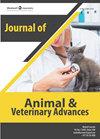钙蛋白酶和钙pastatin活性死后和肉嫩度
引用次数: 5
摘要
钙蛋白酶和钙pastatin蛋白水解酶系统被认为是肉在死后嫩度的主要贡献者。然而,关于钙蛋白酶及其抑制剂钙pastatin以及两者如何影响肉的嫩度,我们所知甚少。这可能是因为了解钙蛋白酶系统的技术研究仍然相对较新。当考虑到影响肌肉向肉转化、肉嫩化以及钙蛋白酶和钙pastatin活性的因素时,很明显,这三个方面所涉及的因素存在重叠。然而,并不是所有影响肉嫩化的因素都能影响钙蛋白酶和钙pastatin酶系统。虽然有研究表明饮食、生长促进剂、性别、天气、动物处理和电刺激如何影响钙蛋白酶和钙pastasttin酶系统,但这些研究并不是结论性的。有鉴于此,尤其需要在南非进行进一步的研究,以充分了解该系统在当地条件下以及在恩古尼、非洲人和博斯马拉等当地肉牛品种下的情况。此外,还需要建立pH与钙蛋白酶和钙蛋白酶活性之间的关系,给出了在这方面持有的相互矛盾的观点。本文章由计算机程序翻译,如有差异,请以英文原文为准。
Calpain and calpastatin activity post mortem and meat tenderness
The calpain and calpastatin proteolytic enzyme system is believed to be the main contributor to the tenderness of meat at post mortem. However, little is known about the enzyme calpain and its inhibitor calpastatin and how the two influence meat tenderness. This could be due to the fact that the study of the technology to understand calpain system is still relatively new. When factors that influence conversion of muscle to meat, meat tenderization and the activity of calpain and calpastatin are considered, it is evident that that there is overlap of the factors involved in the three aspects. However, not all factors that influence meat tenderization have been shown to affect the calpain and calpastatin enzymatic system. Thought there are studies that demonstrate how diet, growth promoters, gender, weather, handling of animals and electrical stimulation influence the calpain and calpastastin enzymatic system, these studies are not conclusive. In view of this, further studies are need particularly in South Africa to understand the system fully under local conditions and in local beef cattle breeds such as the Nguni, Africander and Bosmara. Furthermore, there is a need for work to establish the relationship between pH and the activity of calpain and calpastatins give the conflicting views held on this aspect.
求助全文
通过发布文献求助,成功后即可免费获取论文全文。
去求助
来源期刊
自引率
0.00%
发文量
0
审稿时长
1 months
期刊介绍:
Journal of Animal Veterinary advances is a peer-reviewed, open-access scientific journal which publishes articles related to experiments, treatment, analysis, biological elements and other methods of research connected with veterinary. JAVA started publishing activity in 2002, since that time is updated twice a month, and is available in online and print formats. The publications are reviewed by Editorial Board in accordance with the standards and novelty of the subject, while strictly following ethical guidelines. Subject areas suitable for publication include, but are not limited to the following fields :: Veterinary science :: Animal husbandry :: Animal nutrition :: Anatomy :: Biological science :: Pathology :: Infectious diseases :: Animal physiology :: Animal breeding :: Animal biotechnology :: Transgenic animal production :: Animal parasitology :: Veterinary medicine :: Animal feed and nutrition :: Equine.

 求助内容:
求助内容: 应助结果提醒方式:
应助结果提醒方式:


